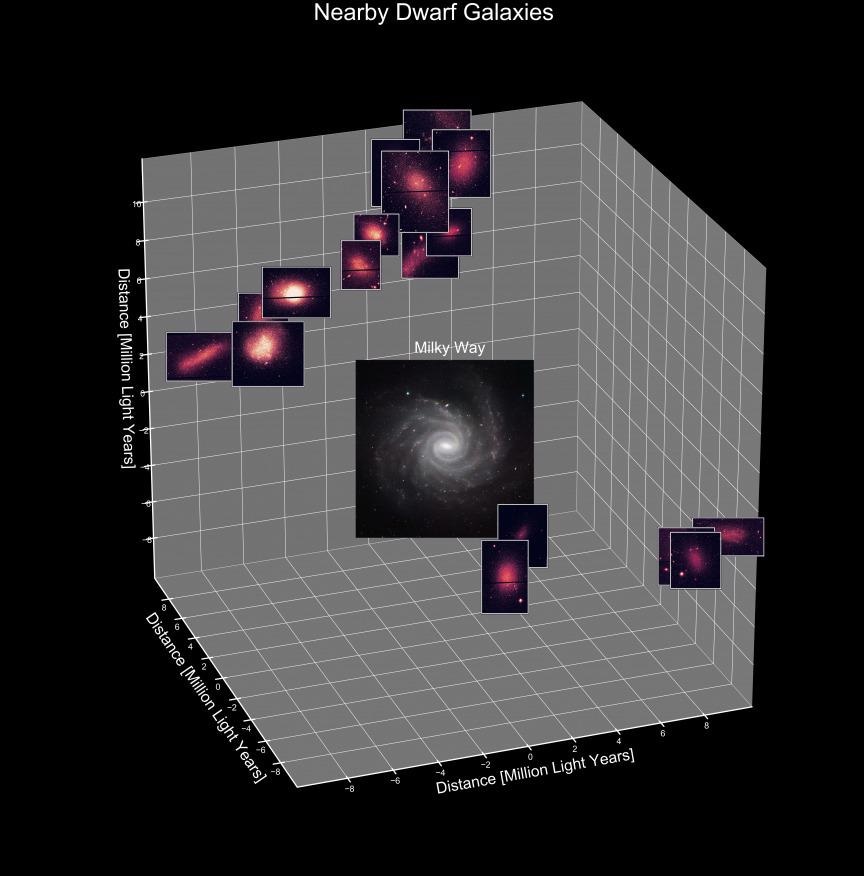May 25 2021
A total of 36 dwarf galaxies situated far away from each other underwent a concurrent 'baby boom' of new stars, a sudden breakthrough that challenges present theories on how galaxies expand and might improve people’s knowledge about the universe.
 The Milky Way-like galaxy NGC 1232 (center) shows the Milky Way’s location and relative size. Images of dwarf galaxies are centered close to their true locations but have been magnified for visibility. Image Credit: Charlotte Olsen.
The Milky Way-like galaxy NGC 1232 (center) shows the Milky Way’s location and relative size. Images of dwarf galaxies are centered close to their true locations but have been magnified for visibility. Image Credit: Charlotte Olsen.
Galaxies located over 1 million light-years apart must have entirely separate lives as to when they give birth to new stars. However, galaxies that are isolated by up to 13 million light-years decelerated and further concurrently expedited their birth rate of stars, as per a Rutgers-led study reported in the Astrophysical Journal.
“It appears that these galaxies are responding to a large-scale change in their environment in the same way a good economy can spur a baby boom,” stated lead author Charlotte Olsen, a doctoral student in the Department of Physics and Astronomy in the School of Arts and Sciences at Rutgers University–New Brunswick.
We found that regardless of whether these galaxies were next-door neighbors or not, they stopped and then started forming new stars at the same time, as if they’d all influenced each other through some extra-galactic social network.
Eric Gawiser, Study Co-Author and Professor, Department of Physics and Astronomy, Rutgers University–New Brunswick
In the 36 dwarf galaxies, the concurrent reduction in the stellar birth rate began six billion years ago, and the increase started three billion years ago. To gain insight into how galaxies develop needs unraveling of the several processes that impact them over their lifetimes (billions of years).
The formation of stars is one of the most basic processes. The birth rate of stars can increase when galaxies interact or collide, and galaxies can prevent making new stars if the gas (mainly hydrogen) that creates stars is lost.
Histories about the formation of stars can paint a rich picture of environmental conditions as a galaxy 'grew up.' Dwarf galaxies are the most general ones but the least enormous ones, and they are particularly sensitive to the impacts of their immediate surroundings.
The 36 dwarf galaxies contained a different series of environments at distances as far as 13 million light-years from the Milky Way. The environmental change that the galaxies responded to should be something that spreads fuel for galaxies that are located at very long distances.
That could imply facing a huge cloud of gas, for instance, or a phenomenon in the universe that no one yet knows about, says Olsen.
Two techniques were utilized by the scientists to match star formation histories. One involves the use of light from individual stars inside the galaxies, and the other involves the use of the light of a complete galaxy, such as a wide range of colors.
The full impact of the discovery is not yet known as it remains to be seen how much our current models of galaxy growth need to be modified to understand this surprise. If the result cannot be explained within our current understanding of cosmology, that would be a huge implication, but we have to give the theorists a chance to read our paper and respond with their own research advances.
Eric Gawiser, Study Co-Author and Professor, Department of Physics and Astronomy, Rutgers University–New Brunswick
“The James Webb Space Telescope, scheduled to be launched by NASA this October, will be the ideal way to add that new data to find out just how far outwards from the Milky Way this ‘baby boom’ extended,” added Olsen.
The Rutgers’ study co-authors include Professor Kristen B. W. McQuinn; Grace Telford, a postdoctoral associate; and Adam Broussard, a doctoral student. Scientists at the University of Toronto, the Harvard-Smithsonian Center for Astrophysics, Johns Hopkins University, and NASA’s Goddard Space Flight Center contributed to this study.
Journal Reference:
Olsen, C., et al. (2021) Star Formation Histories from Spectral Energy Distributions and Color–magnitude Diagrams Agree: Evidence for Synchronized Star Formation in Local Volume Dwarf Galaxies over the Past 3 Gyr. The Astrophysical Journal. doi.org/10.3847/1538-4357/abf3c2.